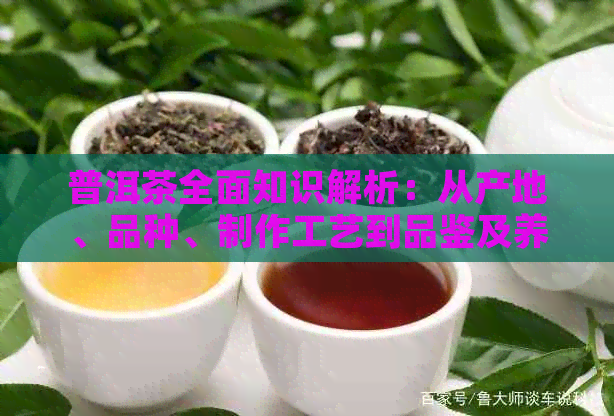Title: Comprehensive Knowledge Analysis of Pu'er Tea: Origin, Variety, Production Process, to Taste reciation and Health Benefits

Pu'er tea, with its unique taste and numerous health benefits, has been captivating tea enthusiasts around the world. This article ms to provide a comprehensive analysis of Pu'er tea, covering its origin, variety, production process, taste reciation, and health benefits.
I. Origin of Pu'er Tea
Pu'er tea originates from the Yunnan province in China, where the climate and altitude provide ideal conditions for tea growth. The history of Pu'er tea dates back to the Tang Dynasty, over 1,000 years ago. It was initially produced for local consumption and later became a popular commodity for trade along the ancient Tea Horse Road.
II. Variety of Pu'er Tea
There are two mn types of Pu'er tea: raw (sheng) and ripe (shou).
1. Raw Pu'er (Sheng Cha): This type of Pu'er tea is made from sun-dried tea leaves that are then compressed into various shapes. It undergoes a natural fermentation process over time, which can take several years or even decades. The flavor of raw Pu'er tea becomes more mellow and complex as it ages.
2. Ripe Pu'er (Shou Cha): Ripe Pu'er tea is made from the same sun-dried tea leaves as raw Pu'er but undergoes an accelerated fermentation process known as wet piling. This process takes about one to two years and results in a tea with a smoother, earthier flavor.
III. Production Process of Pu'er Tea
The production of Pu'er tea involves several steps:
1. Harvesting: Tea leaves are picked from old tea trees, preferably those over 100 years old, as they produce higher quality tea.
2. Withering: The freshly picked leaves are spread out in the sun to wither and lose some of their moisture.
3. Rolling: The withered leaves are rolled to break down their cell walls and release their essential oils, which contribute to the tea's flavor.
4. Drying: The rolled leaves are then dried in the sun, reducing their moisture content further.
5. Compressing: The dried leaves are compressed into various shapes such as cakes, bricks, or balls.
6. Aging: For raw Pu'er, the compressed tea is aged for several years or even decades. Ripe Pu'er undergoes wet piling, an accelerated fermentation process, before aging.
IV. Taste reciation of Pu'er Tea
The taste of Pu'er tea is influenced by its origin, variety, and aging process. Generally, raw Pu'er has a strong, earthy flavor with a hint of bitterness, while ripe Pu'er has a smoother, more mellow taste. The following are some tips for reciating Pu'er tea:
1. Observe the color: The color of the tea soup should be clear and bright, indicating its freshness and quality.
2. Smell the aroma: Pu'er tea has a rich, earthy aroma, with notes of wood, leather, or even flowers.
3. Taste the flavor: Take small sips and let the tea coat your palate. Notice the complexity of flavors, which may include bitterness, sweetness, and umami.
4. Feel the aftertaste: A good quality Pu'er tea will leave a lingering, pleasant aftertaste.
V. Health Benefits of Pu'er Tea
Pu'er tea has numerous health benefits due to its rich polyphenols, antioxidants, and other bioactive compounds. Some of its health benefits include:
1. Weight loss: Pu'er tea can help boost metabolism and promote fat breakdown, making it an excellent choice for weight loss.
2. Cardiovascular health: Regular consumption of Pu'er tea can help lower blood pressure and cholesterol levels, reducing the risk of heart disease.
3. Digestive health: Pu'er tea ds digestion and can help alleviate symptoms of gastrointestinal disorders.
4. Anti-inflammatory effects: The polyphenols in Pu'er tea have anti-inflammatory properties, which can help reduce inflammation and prevent chronic diseases.
5. Antibacterial properties: Pu'er tea has antibacterial properties that can help fight agnst harmful bacteria and improve overall health.
In conclusion, Pu'er tea is a fascinating beverage with a rich history, diverse varieties, intricate production process, and numerous health benefits. Whether you're a tea enthusiast or just beginning to explore the world of tea, Pu'er tea is definitely worth a try.
-
鄂为丨普洱茶知识全部
- 陈年普洱茶丨好的,我可以帮你写一个新标题。请问你需要加入哪些关键词呢?
- 普洱茶知识丨普洱茶的魅力:岁月沉淀中品味古之美
- 普洱茶动态丨普洱茶的极致魅力:从产地、制作工艺到品饮方法的全面解析
- 普洱茶文化丨普洱茶的魅力色彩:从深邃的红到明亮的绿,一次视觉与味觉的宴
- 普洱茶知识丨普洱茶的迷人特点及其更大特征
- 普洱茶养生丨红孩儿药功的全面功效解析:从健、养生到治疗多种疾病
- 普洱茶养生丨药材红孩儿市场价格分析与走势
- 古树普洱茶丨普洱茶的魅力:从历、产地、制作工艺到品饮方法的全面解析
- 普洱茶养生丨整提普洱茶存放需要锡箔纸袋吗?为什么不能使用?
- 普洱茶知识丨北方存放普洱茶的方法与注意事项,让您的普洱茶保持优良品质
- 普洱生茶熟茶丨普洱茶中甜味的成因及其真实性探究
- 普洱茶动态丨普洱茶的甜味来源及其对茶叶品质的影响解析
- 陈年普洱茶丨普洱茶带甜味正常吗?原因是什么?是否加了添加剂?
- 古树普洱茶丨云南普洱茶稀有品种,价格高昂,真的值得投资吗?
- 普洱茶知识丨云南普洱茶价格大全:了解各种类型、和等级的茶叶价格
- 陈年普洱茶丨云南普洱茶多少钱一盘:了解当前市场价格与茶叶斤价
- 普洱茶动态丨2010年云南茶马古道普洱茶价格走势分析与市场前景预测
- 普洱茶知识丨云南司马茶叶:品种、产地、制作工艺、功效与泡法全方位解析
- 普洱生茶熟茶丨茶马诗普洱茶价格表及旗舰店:零年产品最新价格一览
- 普洱茶养生丨普洱茶土司砖价格:探究市场行情与品质之间的关系

